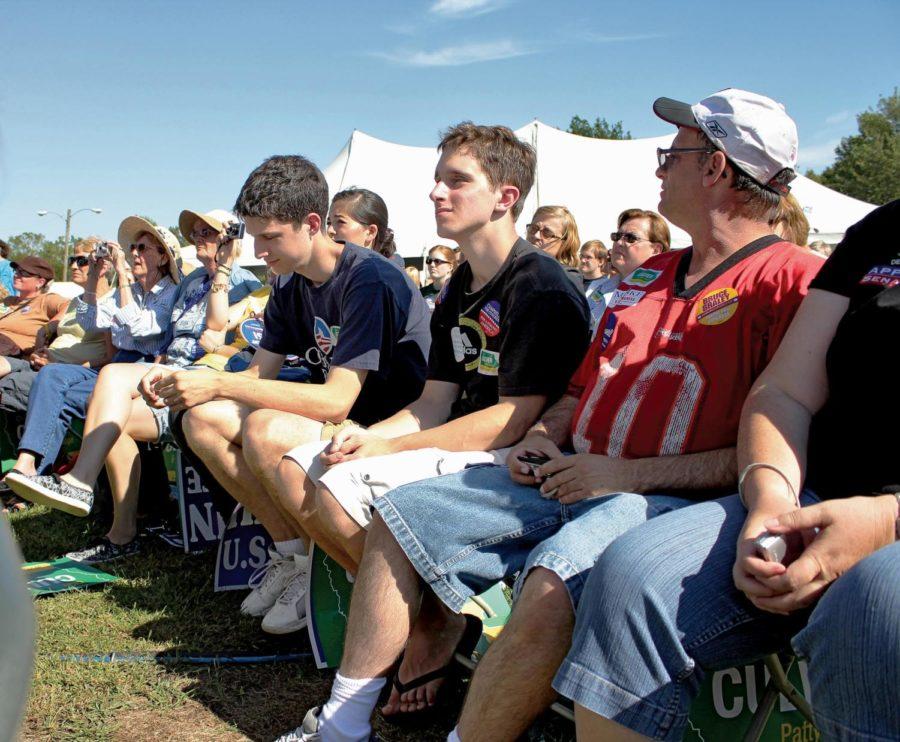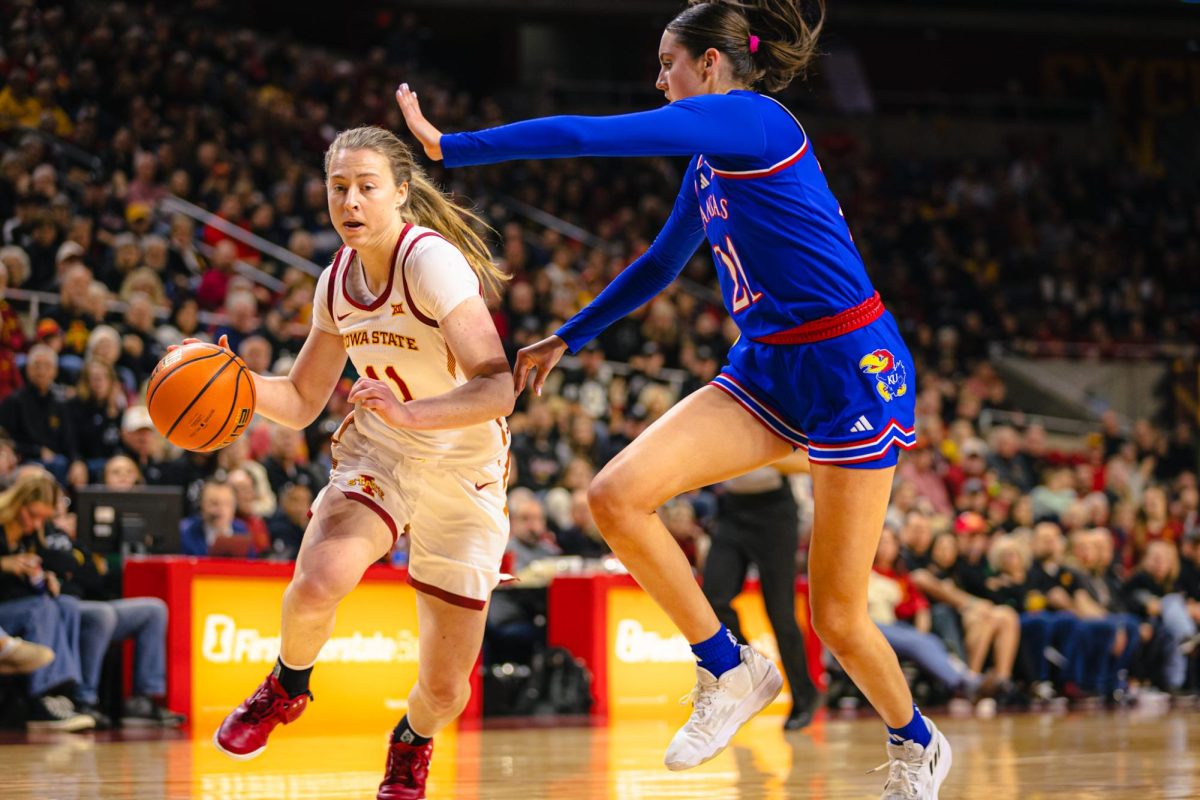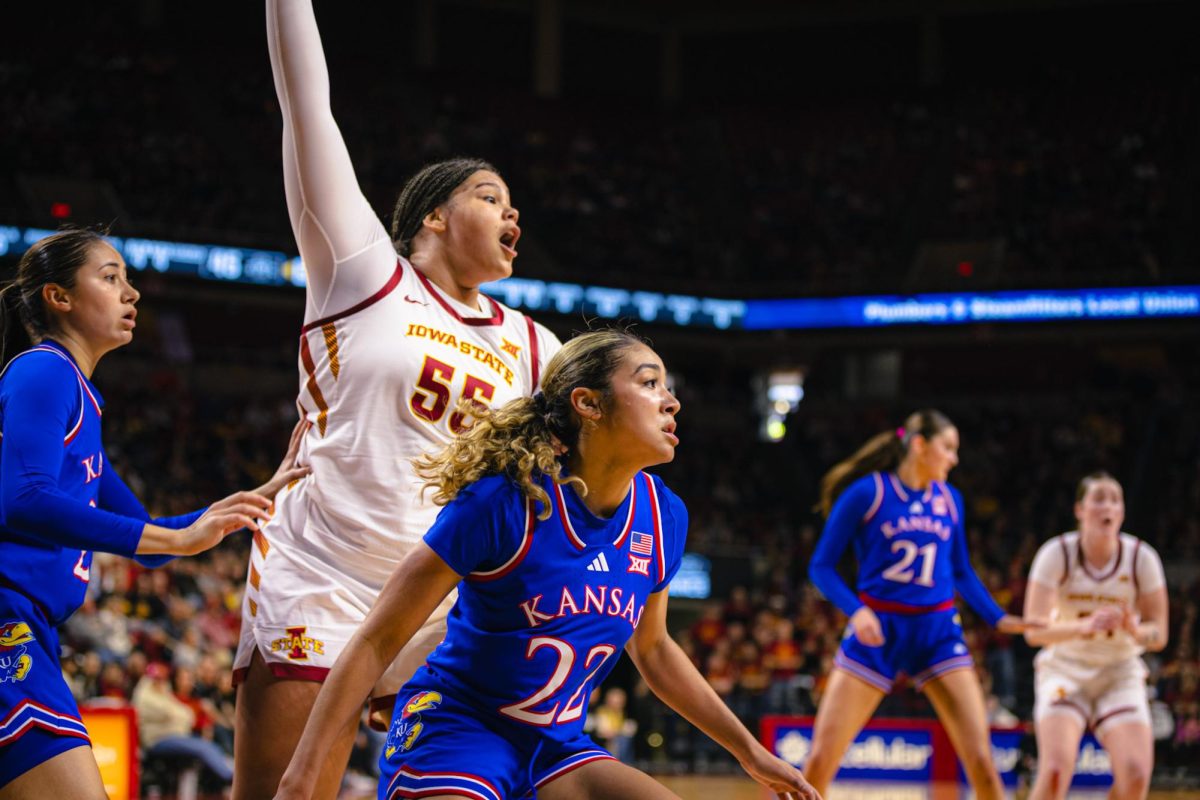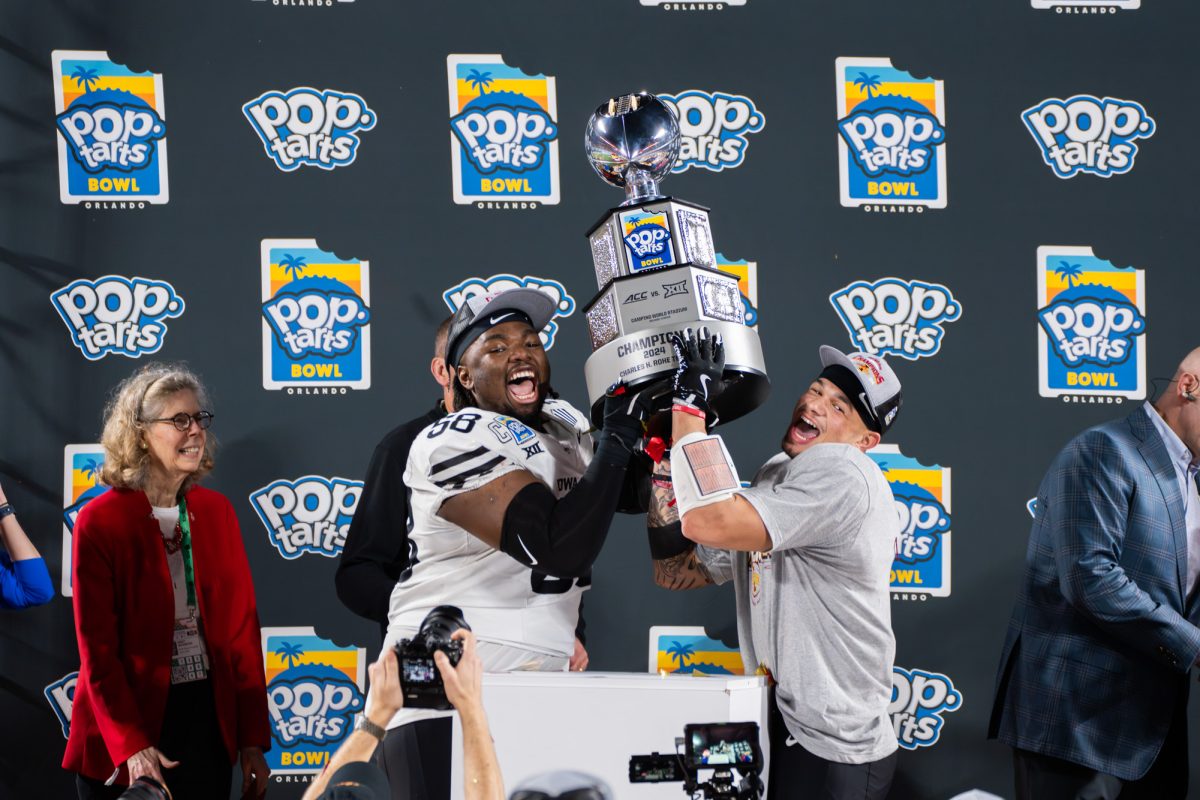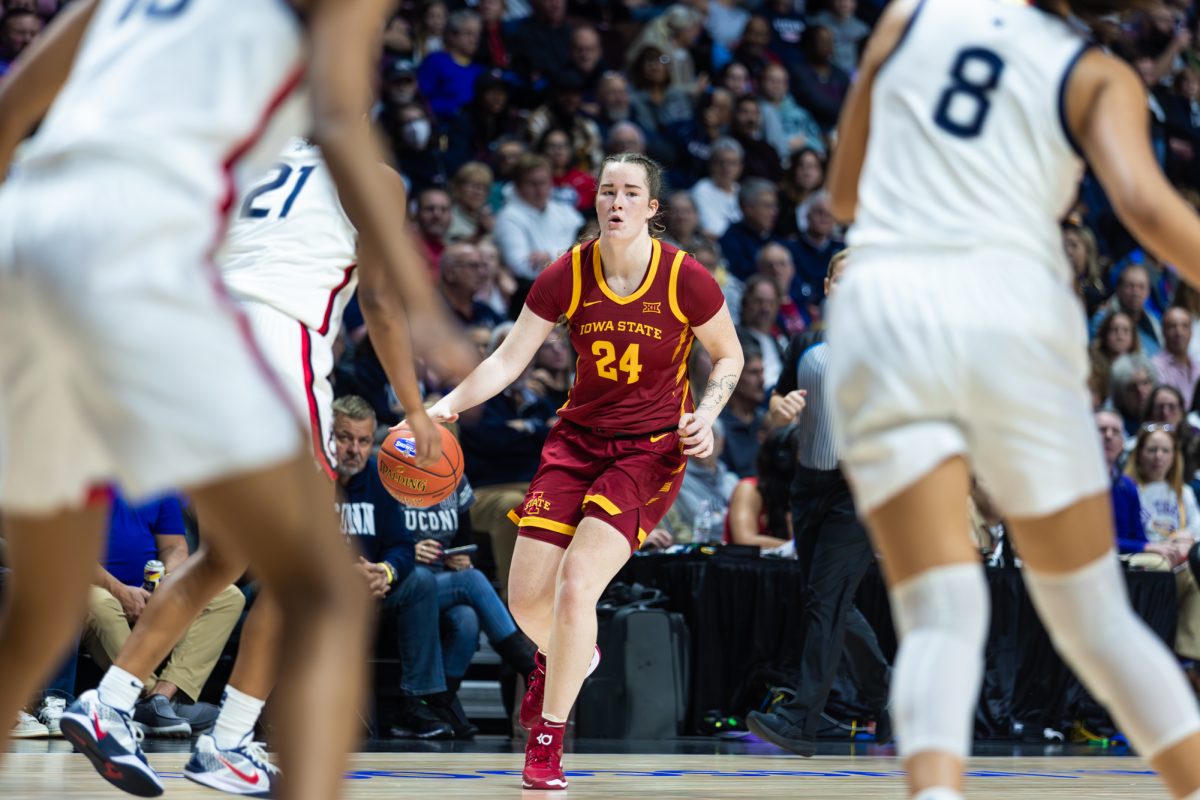Where is the youth vote in 2010?
Photo: Tyler Kingkade/Iowa State Daily
Two young people listen to politicians at the Harkin Steak Fry. In 1008, 66 percent of young voters polled for Barack Obama, but it’s less likely the same turnout will happen in a midterm election.
September 27, 2010
President Barack Obama and the Democrats know they need college students. Actually getting them to vote in a tough midterm is another story.
Youth voters historically do not show up on the first Tuesday in November in the same numbers as older voters, meaning politicians give more attention to the wishes of the American Association of Retired Persons than they do to any group of college students.
A record number of young voters turned out in 2008, but typically less than 30 percent of those under the age of 30 show up for midterm elections.
In 2008, 66 percent of them voted for Obama; 58 percent voted Democratic in House races in 2006.
In a conference call with college journalists Monday, Obama tried to ensure they would return to the polls this year.
“You can’t sit it out,” Obama said. “You can’t suddenly just check in once every 10 years or so, on an exciting presidential election and then not pay attention during big midterm elections where we’ve got a real big choice between Democrats and Republicans.”
The Pew Research Center reports 45 percent of voters ages 18-29 align themselves as Democrats versus only 26 percent as Republicans. This is a huge shift since 2000, when the party registration for the age bracket was nearly even.
NBC exit polling found 45 percent of Iowans under the age of 29 were contacted by the Obama campaign, while only 24 percent heard from the McCain campaign.
That gap closed with each age group, but Obama’s team still kept an advantage of getting vote out in Iowa. There was an even larger gap among young voters in other swing states like Nevada and Pennsylvania.
But in a midterm where Democrats are favored to lose, as the party in power always does, could the youth vote, which only amounts to 17 percent of the 2008 electorate, be a block that could offset Republican chances?
“I think there has not been a very good effort to keep the momentum of enthusiasm among younger voters,” said Steffen Schmidt, university professor of political science. “Younger voters, even though more of them are now registered, they have very little motivation.”
Schmidt pointed out younger voters are preoccupied with school, part-time work, relationships and are often unstable because they move frequently, so getting them to participate in the political process is much more challenging unless the candidates make it worth their time.
“Obama went out and made it worth their time,” Schmidt said. “He provided techniques where younger voters could interact with each other as a part of their participation with him.
“When you have an effort to get people not individually to participate politically but participate as crowds, the success rate is higher. And I don’t see Obama or the Democrats doing anything to keep that crowd mentality, group mentality going.”
He wrote on the Des Moines Register that Democrats, particularly in Iowa, lack a coherent message. Meanwhile the Republicans recently launched “A Pledge to America,” an updated version of the “Contract to America” the GOP put out in 1994.
Leading into the 1994 midterms, when Republicans swept into Congressional power, approval ratings for Congress and former President Bill Clinton were very close to the 2010 numbers. And when the first Tuesday of November came, voters under the age of 30 comprised only 13 percent of the vote.
In a national exit poll by NBC in 2008, only 27 percent of young voters thought “the government should do less,” while 69 percent thought “the government should do more to solve problems” — basically showing an overwhelming amount of young people are left-leaning.
Schmidt said Democrats are failing to get their message across to those voters and illustrating what could be perceived as negative aspects of Republican candidates.
“You have to give people a reason to vote, and young people you have to give them three or four reasons to vote,” Schmidt said. “I don’t see anybody doing that very effectively and that includes the Republicans.”
Obama said Monday the Republicans recently revealed “A Pledge to America” would hurt students who rely on federal loans.
He also said he understood the frustration among young voters who voted for “change” in 2008.
“It doesn’t happen overnight,” Obama said. “You take two steps forward, you take one step back. This is a big, complicated democracy. It’s contentious. It’s not always fun and games. A lot of times, to bring about big changes like, for example, in our energy policy, you’re taking on a lot of special interests — the oil companies and utilities.”
A New York Times/CBS poll conducted this summer found eight in 10 Americans aged 45 and older disapprove of the job Congress is doing, compared with six in 10 of those under age 45.
So going by the trend of young voters voting Democrat over the past decade, if there were to be an unprecedented turnout of young voters in the midterm election this year, it could dramatically shift what national polls predict to be a massive Republican victory.
That means Democrats would need to focus on turning out young voters while Republicans need to work to bring them to their side.
Obama acknowledged the need of college student engagement.
“The energy that you were able to bring to our politics in 2008, that’s needed not less now, it’s needed more now,” Obama said.
Early voting push
Both parties in Iowa are putting stock in an early vote push.
Secretary of State John Mauro repeatedly tells supporters voting day begins not Nov. 2, but rather begins Sept. 23 — the first day early voting is allowed in Iowa.
The Iowa Democratic Party launched a website, IowaVotesEarly.com, devoted to helping people find out how to vote early and request absentee ballots.
IDP Chairwoman Sue Dvorsky said it’s an attempt to capitalize on technology while continuing traditional practices like phone calls and going door-to-door.
In the same week, the Iowa Republican Party released IowaGOP.org/voteearly.
Tim Albrecht, communications director for the Terry Branstad gubernatorial campaign, said while Republicans typically focused on getting out the vote on election day, this year they’re also encroaching on Democratic territory in Iowa by pushing early voting stations in every county.
Albrecht believes the issue of job prospects and whether the state is losing or creating jobs, is a large factor among young people on the verge of entering the job market, so it would favor Branstad in 2010.
He said in the final weeks before the election, Branstad would take that message directly to college students.
“Terry Branstad has already hit all of Iowa’s 99 counties, now his focus is on hitting every single college and university in this state and he’ll do it,” Albrecht said.
Hitting the campus
“Voting is a habit,” Dvorsky said, explaining each time someone votes, the more likely they’ll participate again.
Dvorsky understands midterms always present a challenge to get voters to turnout but she said the way they’re handling young voters is the same as how they handled it in 2008 and how they handle older voters.
“It is absolutely part of the mentoring of these young people who were voters … and first-time voters, whatever their age is to get them to do it twice,” she added.
Dvorsky said it’s vital to go to them, which means hitting the campuses.
Caroline Dvorsky is the president of Hawkeyes for Culver, the Culver-Judge effort, as a part of the College Democrats at the University of Iowa. She said a lot of their work includes grassroots outreach to students.
“We’ve been tabling every day out around campus, just trying to get kids registered to vote, letting them know where voting locations are and things like that,” Caroline Dvorsky said.
An issue of great importance to students in Iowa City is a local ballot measure on whether to require all bars to go from age 18 and up to 21 only, similar to Ames.
“I think a lot of kids will come out to vote just on that issue and what we’re trying to do is to get them to flip the ballot and vote on candidates too,” Caroline Dvorsky said.
Dvorsky characterized 2008 as a unique year because the Obama campaign focused heavily on younger voters.
“I do think we still have some of that enthusiasm this year getting out the midterm because there’s such hotly contested races across the board,” she said.
Obama said Monday he would encourage young people not just to vote, but to make an educated vote in the midterms.
“You’ve got to take the time to find out where does your congressional candidate stand on various issues, where does your Senate candidate stand on various issues and make an educated decision and participate in this process — because democracy is never a one-and-done proposition,” Obama said. “It’s something that requires sustained engagement and sustained involvement.”
Gov. Chet Culver said Organizing for America, Obama’s campaigning arm, will help Democrats by targeting those young voters who came out in 2008.
“We have no doubt we’re going to be able to move them, it won’t hurt at all the president will be here next week,” Culver said at the Organizing for America Des Moines office Sept. 22.
Obama will be in Des Moines for an official economic event Wednesday, but since it’s on the taxpayer dime he will not be campaigning.
Schmidt said it would be good to see Obama talking to the troops and trying to keep enthusiasm up.
“Go and have town meetings of the next generation,” Schmidt recommended. “Millennial town meetings and Obama flies in and talks to 10,000 young people in a big auditorium and say, ‘The future is yours.'”
It seems that may be exactly what Obama intends to do Tuesday when he will broadcast a rally of him with young voters in Wisconsin live, and the ISU Democrats will meet in Ross Hall to hear a message from the president about involvement in the election.
Overall, though, Schmidt predicted the turnout will be mediocre.
“The youth vote has been abandoned again,” Schmidt said.


